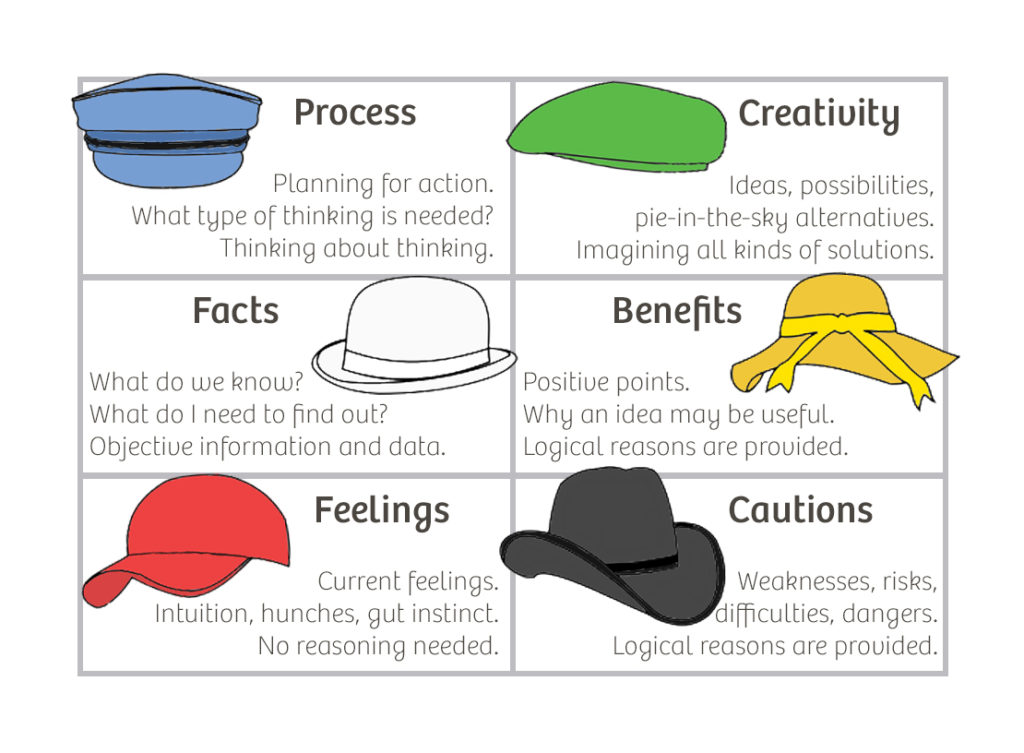What It Is:
Six Thinking Hats is a thinking and decision-making technique developed by Edward de Bono, a Maltese physician, psychologist, and author. The method is designed to improve the quality and efficiency of group discussions and decision-making processes. It involves individuals adopting different perspectives represented by six metaphorical “hats.”
Six Thinking Hats:
- White Hat:
- Focus: Facts and Information.
- Role: Objective and neutral; focuses on available data, information, and facts.
- Red Hat:
- Focus: Emotions and Feelings.
- Role: Expresses emotions, intuitions, and gut feelings without needing to justify them.
- Black Hat:
- Focus: Critical Judgment.
- Role: Points out potential risks, drawbacks, and concerns. The “devil’s advocate” hat.
- Yellow Hat:
- Focus: Positive Judgment.
- Role: Identifies benefits, advantages, and opportunities. Encourages optimistic thinking.
- Green Hat:
- Focus: Creativity and Ideas.
- Role: Generates creative solutions, possibilities, and alternatives. Encourages thinking “outside the box.”
- Blue Hat:
- Focus: Process Control.
- Role: Manages the thinking process, sets agendas, and guides the use of other hats. Facilitates the discussion.
How to Use It:
Using Six Thinking Hats in Agile Coaching:
- Decision-Making Meetings:
- Incorporate the Six Thinking Hats technique during decision-making meetings. Start with an exploration of facts, then emotions, followed by critical judgment, positive judgment, creativity, and finally, process control.
- Problem-Solving Sessions:
- Use the hats to guide problem-solving sessions. Begin with an objective analysis of the problem (White Hat), then explore emotional responses (Red Hat), analyze potential risks (Black Hat), identify opportunities (Yellow Hat), generate creative solutions (Green Hat), and manage the discussion process (Blue Hat).
- Retrospectives:
- Apply the Six Thinking Hats in retrospectives to analyze the team’s performance. Each hat can be used to review different aspects, such as facts (White Hat), team dynamics (Red Hat), challenges faced (Black Hat), achievements (Yellow Hat), improvements (Green Hat), and the retrospective process itself (Blue Hat).
- Innovation Workshops:
- Facilitate innovation workshops using the Six Thinking Hats to guide the generation of creative ideas and solutions. The Green Hat encourages participants to think creatively and explore unconventional possibilities.
Integrating Six Thinking Hats into Agile practices enhances team collaboration, creativity, and decision-making. It offers a structured approach to explore various perspectives, encouraging a more comprehensive and well-rounded analysis of situations.
References:
- Books by Edward de Bono:
- Edward de Bono has written extensively on creativity and thinking methodologies. His book “Six Thinking Hats” provides an in-depth explanation of the technique and its applications.
- Training and Workshops:
- Explore training programs or workshops on Six Thinking Hats. These sessions may provide hands-on experience and practical insights into applying the technique.
- Online Articles and Case Studies:
- Numerous articles and case studies discuss the application of Six Thinking Hats in various contexts, including business, education, and problem-solving. Online resources can provide practical tips and real-world examples.
- Facilitation Guides:
- Look for facilitation guides that offer step-by-step instructions on using Six Thinking Hats in different scenarios. These guides can provide templates and techniques for effective implementation.
Visit the Agile Coach’s Toolkit for more definitions, models, theorems and stuff.

